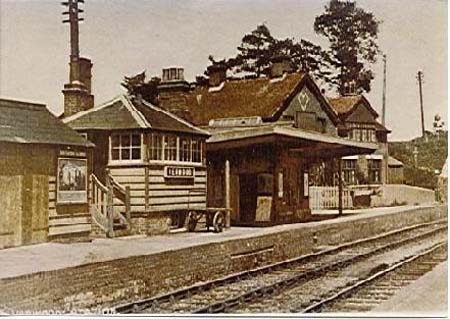|
Communications
in Verwood.
|
The eighteenth century brought with it the building
of many turnpike roads. In 1756 there were several
turnpike roads from Poole Gate into
Cranborne Chase and in 1759 two
more were established in the area, one from
:-
through Romsey, Ringwood, Longham to Wimborne Minster
and from
Ringwood through Woolsbridge,
Horton and Thickhorne to Cashmore.
1760 found Cranborne on the high road from
London to the west. A turnpike road from Poole
Gate to Salisbury through Cranborne Chase was established by
Act of Parliament in the reign of George III, a milestone
can still be seen on the roadside between Toyd Farm and the
Blandford-Salisbury road marking this turnpike. These roads
brought more people to the area. The smugglers certainly
used the roads, the Chase woods being a good refuge when
conveying their contraband from the coast to inland
destinations.
 Shawn
Shaw has reported following the road from Cranborne to Tidpit, across Toyd Down
in 2007 where he saw many of these milestones still in place.The one shown in
the photograph (taken by John Barnaby of Poole) is 11 miles from Cranbonre
[as spelt on the stone]. At 2 miles it is the closest to Cranborne and is painted
white with black lettering. The rest were less well conserved. Shawn
Shaw has reported following the road from Cranborne to Tidpit, across Toyd Down
in 2007 where he saw many of these milestones still in place.The one shown in
the photograph (taken by John Barnaby of Poole) is 11 miles from Cranbonre
[as spelt on the stone]. At 2 miles it is the closest to Cranborne and is painted
white with black lettering. The rest were less well conserved.
Telegraph Hill to the
north of Verwood was a landmark in Napoleonic
times. It was one of a line of telegraph posts strung
out across the country from
London to
Plymouth. It has been said that this system of
semaphore could flash a message from Devon
to
London, and carry a reply within minutes. It
was this semaphore system which helped carry the news of
Nelson's Trafalgar and
Wellington's
Waterloo.
Cross country communications with South Hampshire
and the Bristol Channel
were improved in 1832 when the Cranborne Chase and New
Forest Turnpike was built. Some late nineteenth century maps
suggest that the road from Verwood to Cranborne was included
but there is no record of this.
 The railway was built
in 1867 and was part of the
Salisburyand Dorset
branch of the
London and South West
Railway.
It is interesting to note that it was Verwood station that
served Cranborne. The railway lasted for just under one
hundred years, and in 1968 the station was derelict and the
rails had been taken up. Currently the Albion Inn and
the now unused railway bridge can still be seen but the rest
of the station buildings have been demolished to make way
for a new road and housing. (select
here to see the separate article on Verwood Station.) The railway was built
in 1867 and was part of the
Salisburyand Dorset
branch of the
London and South West
Railway.
It is interesting to note that it was Verwood station that
served Cranborne. The railway lasted for just under one
hundred years, and in 1968 the station was derelict and the
rails had been taken up. Currently the Albion Inn and
the now unused railway bridge can still be seen but the rest
of the station buildings have been demolished to make way
for a new road and housing. (select
here to see the separate article on Verwood Station.)
In 1968 the only public transport was provided by
the Hants and Dorset bus company, which linked Verwood with
Ringwood and Bournemouth
and on certain days with Wimborne. The buses then ran at
two hourly intervals and one's own transport was and still
is a great asset. Currently due to the increase in the size
of Verwood and the privatisation of the countries bus
services, new routes have been introduced as well as the
frequency, with currently 3 companies competing.
Copyright © P Reeks.
|